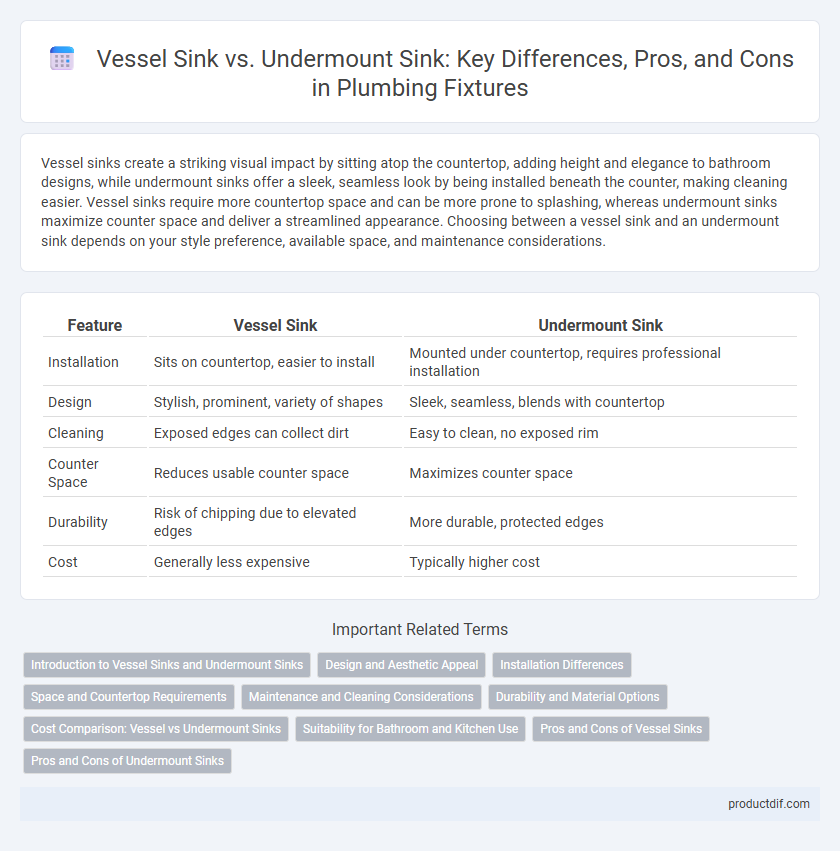Vessel sinks create a striking visual impact by sitting atop the countertop, adding height and elegance to bathroom designs, while undermount sinks offer a sleek, seamless look by being installed beneath the counter, making cleaning easier. Vessel sinks require more countertop space and can be more prone to splashing, whereas undermount sinks maximize counter space and deliver a streamlined appearance. Choosing between a vessel sink and an undermount sink depends on your style preference, available space, and maintenance considerations.
Table of Comparison
| Feature | Vessel Sink | Undermount Sink |
|---|---|---|
| Installation | Sits on countertop, easier to install | Mounted under countertop, requires professional installation |
| Design | Stylish, prominent, variety of shapes | Sleek, seamless, blends with countertop |
| Cleaning | Exposed edges can collect dirt | Easy to clean, no exposed rim |
| Counter Space | Reduces usable counter space | Maximizes counter space |
| Durability | Risk of chipping due to elevated edges | More durable, protected edges |
| Cost | Generally less expensive | Typically higher cost |
Introduction to Vessel Sinks and Undermount Sinks
Vessel sinks sit on top of the countertop, creating a stylish and elevated look often chosen for modern or artistic bathroom designs. Undermount sinks are installed beneath the countertop, offering a seamless and clean appearance that simplifies countertop cleaning and maximizes space. Choosing between vessel and undermount sinks depends on factors like bathroom size, countertop material, and aesthetic preference.
Design and Aesthetic Appeal
Vessel sinks create a bold visual statement with their elevated bowl design, making them ideal for contemporary or artistic bathroom setups. Undermount sinks offer a sleek, seamless look by being installed beneath the countertop, enhancing minimalist or modern design aesthetics. Both options provide distinct design advantages, with vessel sinks serving as a focal point and undermount sinks emphasizing clean lines and countertop space.
Installation Differences
Vessel sinks sit atop the countertop and require only a single hole for the drain, making installation less invasive but needing precise measurements to support the sink securely. Undermount sinks are installed beneath the countertop, requiring cutouts matching the sink's exact dimensions and strong adhesive or mounting clips for a seamless, stable fit. The installation of undermount sinks demands professional cutting and sealing to prevent water damage, while vessel sinks allow easier access for repairs or replacements.
Space and Countertop Requirements
Vessel sinks require more vertical space since they sit above the countertop, making them ideal for bathrooms with higher vanity heights and more open space. Undermount sinks maximize countertop space because they are installed beneath the surface, allowing for seamless edges and easier cleaning. When countertop material is limited or streamlined aesthetics are desired, undermount sinks provide a more efficient solution by preserving surface area and enabling better organization.
Maintenance and Cleaning Considerations
Vessel sinks require frequent cleaning around the base to prevent water buildup and mold due to their exposed design, while undermount sinks offer easier countertop cleaning with fewer crevices for dirt accumulation. The elevated position of vessel sinks can lead to water splashing on surrounding surfaces, demanding more diligent upkeep to maintain hygiene. Undermount sinks, integrated beneath the countertop, reduce the risk of grime buildup and simplify daily maintenance, making them a practical choice for busy households.
Durability and Material Options
Vessel sinks are often crafted from materials like glass, ceramic, and stone, offering durable surfaces resistant to heat and stains, though they can be more prone to chipping due to their elevated design. Undermount sinks typically use stainless steel, porcelain, or composite granite, providing exceptional durability and resistance to impact and scratches, making them ideal for heavy daily use. Material choices for undermount sinks enhance long-term wear and maintenance ease, while vessel sinks prioritize aesthetic appeal with diverse material options.
Cost Comparison: Vessel vs Undermount Sinks
Vessel sinks typically cost between $150 and $400, making them moderately priced but often requiring additional installation expenses due to their above-counter design. Undermount sinks range from $200 to $600, with higher prices reflecting the complexity of installation and the need for precise countertop cutouts. Overall, undermount sinks tend to have higher upfront costs, but vessel sinks may incur extra maintenance and plumbing adjustments that impact total expense.
Suitability for Bathroom and Kitchen Use
Vessel sinks provide a stylish, elevated basin ideal for bathroom vanities, offering easy installation and diverse design options but may lack practicality in kitchens due to limited counter space and splash potential. Undermount sinks, installed below the countertop surface, are highly suitable for both bathrooms and kitchens, providing a seamless look and easy cleaning with durable materials like stainless steel or composite. For kitchen use, undermount sinks are preferred due to their larger size, better water containment, and compatibility with heavy-duty usage, while vessel sinks excel in bathroom settings for aesthetic appeal and space-saving configurations.
Pros and Cons of Vessel Sinks
Vessel sinks offer a striking aesthetic appeal and easy installation, making them ideal for modern and artistic bathroom designs. However, they can be more prone to splashing and require more frequent cleaning due to exposed surfaces. Their elevated position may limit counter space and present challenges for taller users or those with mobility issues.
Pros and Cons of Undermount Sinks
Undermount sinks create a sleek, seamless look by being installed beneath the countertop, allowing for easy countertop cleaning without edges to trap debris. They are ideal for solid surface materials like granite or quartz but require professional installation and a sturdier countertop for support. However, undermount sinks can be more prone to water damage if the sealant wears out, and repairs may be more complicated compared to vessel sinks.
vessel sink vs undermount sink Infographic

 productdif.com
productdif.com